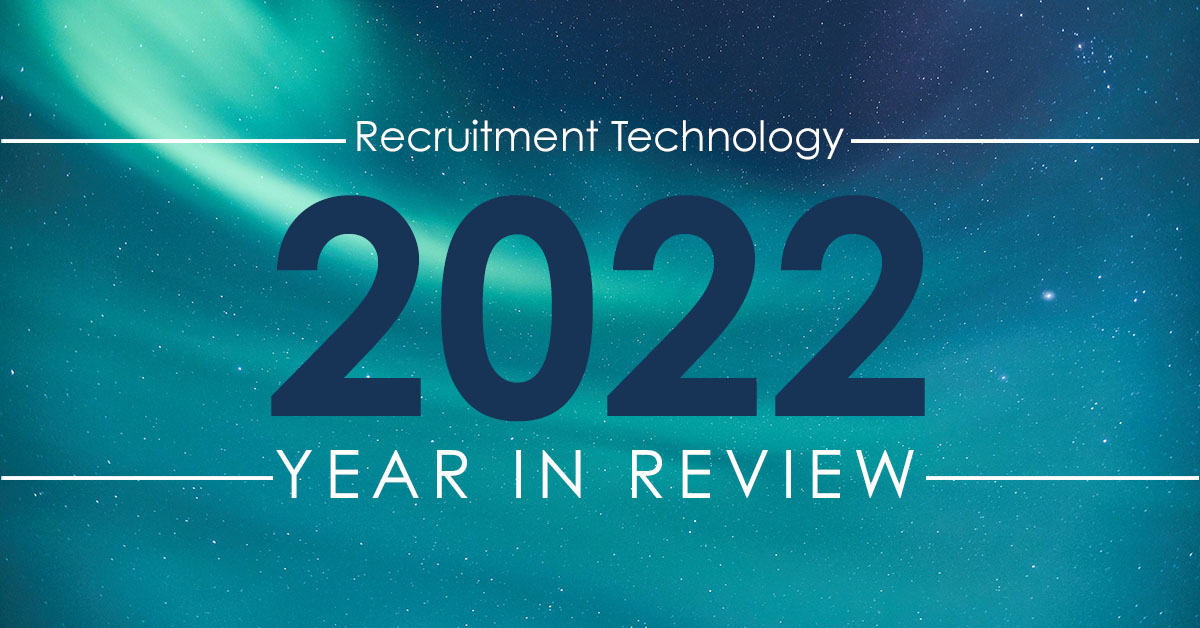With 2022 coming to a close, we’ve chosen this time to reflect, be grateful and plan for the year ahead. We’re taking a moment to think about what has been achieved in recruitment technology and look forward to what’s next.
As uncertain as the past few years have been, some of the most challenging in history, we forged on while looking ahead. The resilience and perseverance of those in recruiting and staffing have been astonishing and quite admirable.
Recruitment technology, as a whole, boomed as both staffing agencies and in-house recruiting pivoted to the next challenge. Many were quick on their feet in adapting to the changes the last few years have brought.
Automation: Why the need for speed?
The requirement for recruitment process automation in 2022 became a reality. Companies that were headed toward more automated processes completed the move and not only invested in Applicant Tracking Systems (ATS), but in supplemental technology built to enhance systems. Others who hadn’t fully anticipated the need as quickly as it came, realized that to stay competitive they needed to automate.
As the ATS market grew, so did the demand for automation and speeding up recruitment processes. As many as 55% of HR professionals said that their companies are now spending more on recruitment technology. 45% are spending more to upgrade their existing tech stack and 38% are purchasing new technology.
The need for speed through automating tasks with AI and NLP was realized as competition grew in these areas. The faster you can source, the faster you can fill positions. It all boils down to the fact that time is money and the quicker the hire, the better the return on investment is.
The importance of data integrity
One important question we should make a habit of asking ourselves is, “What is the objective of my recruitment database?” This keeps goals in mind so workflows are clear. Of course, the purpose of our recruitment database is to collect and store candidate information so we can build a solid and ever-increasing talent pool of qualified candidates.
But if that data becomes outdated and duplicates are pulled in as well as all kinds of other disparate data, we begin to have an ill-functioning, inefficient mess on our hands.
With the slowdown of the pandemic, many took this time to clean databases and begin to beef up their tech stacks. Now, in 2022 a couple of years down the road, and with an abundance of new, updated candidate data rolling in, some found themselves sliding back toward the mayhem of an ill-functioning database. Companies took note and realized that this doesn’t have to happen.
No matter where candidate data is collected, whether it be from job boards, company application portals, emails, or any other source, there is a need for data to be complete, thorough and clean. When importing the data, it’s crucial that from the entry point it be clean and fully enriched. When compared to the data already in your ATS, it should be deduplicated and updated.
This is important because the candidate data in your database is your money-maker. To have clean data that can be searched over quickly and efficiently makes sense. Dealing with incorrect, outdated or incomplete data leads to faulty and corrupted results when you are searching for qualified candidates to fill specific roles.
With that, 2022 was a year where recruiting professionals looked for automated candidate data-loading solutions like Daxtra Capture, that would deliver clean, rich candidate data — only creating a profile in the ATS if it were new and updating any existing profiles.
Recruiters recognized that the health of the database and the integrity of the candidate data within it was crucial in sourcing the best candidates quickly.
High-volume hiring
It also registered that because data flows into ATS from diverse sources it is critical to make sure it is coming in via a solution that can handle high volumes of disparate data without compromising performance.
The growing need for high-volume hiring pushed automation to the next level. Manual data entry was not going to suffice when there were multitudes of new and updated resumes to deal with.
Automated sourcing tools that accomplished resume parsing, data loading, and search and match pushed to the front of desired technology with the volumes of jobs to fill.
The demand for AI automation technology built to handle vast numbers of incoming resumes and applications rose to a new level. Sourcing using best-of-breed ATS enhancements like Daxtra Search Nexus soared. The software is designed to quickly and accurately manage volumes of incoming data and to find, match and shortlist qualified candidates to positions.
To lower marketing costs, investments were made in tools to add productivity and efficiency to the hiring process. Solutions that simultaneously search over the database and job boards all from within the ATS became popular.
Also popular in 2022 were automated search agent functions set up to search across all sources every night and results are delivered directly to an email inbox, ready to review and add to the database, shortlist or tearsheet.
This is configured to automatically load the top 50 candidates into the ATS, leaving no wait time for the user to view. This function builds the database and maximizes job board views so every dollar of job board marketing spend is maximized.
Any function that saved time like saved searches, building and saving collections of search terms and searches, and saved hours of sourcing time made life easier for the recruiter whose focus was on high-volume recruiting.
The growing importance of DEI
A continued concentration on Diversity, Equality and Inclusion began to take on more of a holistic approach in 2022, defining diversity as the presence of differences more so than just physical differences. This can mean not being limited to, ethnicity, gender, religion, sexual orientation, (dis)ability, age, nationality, socioeconomic status, race, language, religion, or political perspective.
To consider all equally often begins at the sourcing stage of building a company’s workforce. However, often unconscious bias plays a larger role than we would imagine in the hiring process.
Means to mitigate unconscious bias by sourcing, matching and ranking using technology had a strong impact.
In the sourcing process candidate search based on skills, automated data loading and resume anonymization placed a focus on skills and abilities relevant to the opening rather than names, dates, school names, and affiliations. This way rather than let other insignificant details influence our decisions, bias-causing criteria were left out of the equation.
Conclusion
The upward trend of the ATS market is evident in the growing demand for recruitment process automation and the ability to speed up recruitment processes. Remote working models have pushed the need for AI and Machine Learning which promises to speed up the recruitment process through job and resume parsing.
The need for sourcing enhancements in the form of software that integrates with the ATS has been and will continue to be in the years ahead, one of the most important investments a staffing agency or in-house recruiting department can make. This technology will only continue to improve and make sourcing talent a quicker, more efficient process.
Even with all of the challenges that came the way of our industry in 2022 and before, our hats are off to those in recruiting and staffing who have pressed on and continue to succeed.
From our team of diligent professionals to our partners and the army of talented recruiters who build their businesses with us, thank you for being a part of this incredible community.
Here’s looking to 2023!
We're here to help you build your tech stack to help you source quicker and more efficiently from within your ATS or CRM. To get a comprehensive idea of what we can do to fill GPS and speed processes, contact us to get a demo of our products and services.



